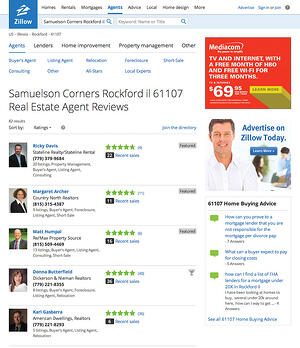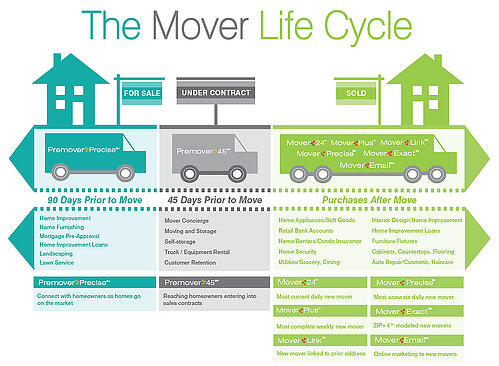
- Homeowners spent an average of $9,400 on purchases during a three-month relocation period.
- 15% of homeowners bought a computer within eight weeks of their move at an average price of $2,160.
- 12% of all moving homeowners bought a car; 66% of these made the purchase within four weeks after moving.
- 57% of owners bought furniture within the 12 weeks surrounding their move; they spent an average of $3,500.
- 35% of owners bought bedding; of these 72% did so within three months after their move, for an average of $420.
- 55% of moving homeowners purchased at least one major appliance.
- 12% of all respondents with Internet access researched moving companies on the web; 8% researched real estate sites, 7% researched appliances/furnishings,
- 2% researched electronics, computers and banking services.
- 6% of movers using the Internet for research actually made purchases online; those buying goods and services spend an average of $600 online.
We also know, based on recent statistics, that new movers tend to be between the ages of 18 and 44. The largest category of new movers falls between 24 and 34. These movers are more likely to be single and earn between $50,000 and $74,999. So it’s normal that these new movers tend to shop online and that’s where your focus should be if you have a product that falls into the DIY channel.
Of course, married couples with children are also moving and this large segment can be reached online as well.
Lifecycle Strategies
The purchase journey for recent movers begins before they move, of course, and continues through several months of heightened purchase intent following their relocation. Delivering content at each stage of that cycle, and utilizing different media vehicles to do so, can be an effective model for marketing of home products and services.
Phase 1: Awareness – Research - Comparison

Nearly all movers begin their journey by searching online for possible rentals or to purchase a new home. Sites like Zillow.com, Trulia.com (now part of Zillow) and Realtor.com point movers in the right direction. These sites provide an excellent opportunity to spread awareness about your product and a chance for the mover to research the benefi ts of your product or service. Banner ads on these sites can be geo-targeted and overlayed with a behavioral targeting platform that will quickly reach the buyers you seek.
Zillow has over 70 million unique users each month. Their research shows movers were from 46% to 77% likely to switch brands or start using a new brand when they moved. Consumer package goods (CPG) and financial services are among categories benefitting most from exposure at this stage.
Phase 2: Selection – Purchase
The window of opportunity for you to sell your product or service tends to last about 7 months. Movers estimate an average time of 7 months that their move impacted their decision relating to purchasing products and services for their households. During this time, new movers are searching online for new appliances, furniture, electronics, financial services, tools and even automobiles.
The list is never ending of the new mover’s wants and needs. Your search engine marketing (SEM) should be fine tuned at this stage of the lifecycle. Keywords, text and display ads should contain consistent and compelling reasons to purchase your product. If your company can offer a solution, then you have an opportunity to gain first-time conversions and repeat customers. Typical search engine advertising can be very effective, but if you take it a step farther and use network inventory to retarget your website, the results can easily triple your traffic.
Source: Google AdWords
For example, a company that sells paint and primer might retarget website visitors from the company page and then follow them to sites like thisoldhouse.com, bobvila.com, doityourself.com and livelovediy.com. From this retargeting, the company could expect to generate 100M – 500M cookies, 10B+ impressions a week, and pay $1 to $1.50 per click-through. You can also place your retargeted display ads on mobile apps and relevant videos.
Phase 3: Experience – Retention – Word Of Mouth
The final stage in the purchase lifecycle can most easily be targeted by social and email efforts. Once a customer has purchased, it’s up to you to provide a positive experience that will lead to repeat purchases and your consumer telling his/her friends about your products.
Don Hinman, senior vice president of data strategy at Epsilon states, “Word of mouth carries a lot of weight, so it’s important to identify your brand advocates and maintain a relationship. With an understanding of who your consumers are and what their current needs are, you can craft a more effective dialogue and drive desired behaviors.” If you can deliver a positive experience on a product or service during a move, then you’ve won yourself a long-term, loyal customer.
New movers represent a significant opportunity to capture a new audience for your DIY product or service. These new movers have long been sought after by businesses given their propensity to respond to marketing communications in many forms. Let Heinzeroth Marketing Group help you utilize the right form of communication in the consumer lifecycle for your product or service.
Call us if you'd like to talk about your campaign efforts with recent movers, or any other home improvement market segment.





